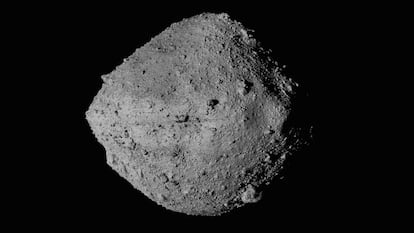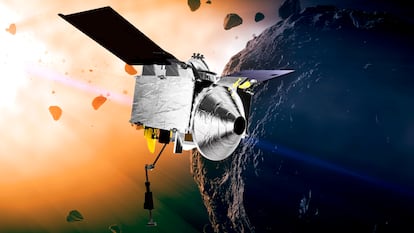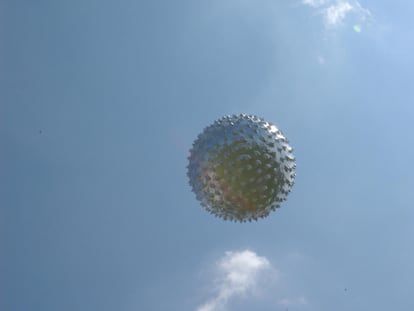A messenger from the origin of the solar system set to arrive in the Utah desert
NASA’s OSIRIS-REx probe is bringing a capsule carrying samples from Bennu, the asteroid on a potential collision course with Earth

In science fiction movies, if someone is on an asteroid, they are probably mining a valuable metal, serving time as a prisoner for some interplanetary felony, or sacrificing their life to save the Earth from an imminent impact and hoping, perhaps, that their name will grace some institute or other in Idaho. But, at 8.55 a.m. local time (4:55 p.m. CEST) in the Utah desert this Sunday, the prequel to those cheesy action movies will be played out. A capsule carrying samples from the surface of Bennu, a 500-meter-long asteroid, is scheduled to arrive. The capsule’s landing will be covered live on NASA’s YouTube channel.
Unlike the action movie heroes who bring their physical strength to bear on fictional near-Earth asteroids, the engineers and scientists responsible for the NASA mission (the third to bring asteroid material back to Earth, after the two Japanese Hayabusa missions) are using their mental prowess. The round trip mission to the asteroid Bennu, an object the size of a shopping mall that orbits the Sun between Mars and Earth, is a display of technical and scientific precision. After a seven-year journey, the probe landed on Bennu, more than 300 million kilometers (186 million miles) away from Earth. It approached the surface, landed on the celestial body that has only a tiny gravitational pull, collected at least 250 grams (9 ounces) of dust and rocks from its surface and took off again to begin its journey home.
As was already known by those in charge of the Japanese space agency JAXA (pioneers in sending spacecraft to gather asteroid dust), placing a probe in the orbit of such a small body requires particular expertise. Rather than entering its gravitational field, as man-made objects do when visiting planets or moons, Hayabusa 1 caught up with the asteroid Itokawa on its way around the Sun. Bennu, a little larger than Itokawa, has become the smallest object ever orbited.
After catching up to the asterioid, the descent to collect the sample on an unknown surface is fraught with danger. In 2005, Hayabusa 1 was only able to collect a few particles after a failure in its collector, and that semi-success was not known until 2010, after a bumpy five-year return. Hayabusa 2, the improved version of its predecessor, managed to bring back five grams (0.18 ounces) of the asteroid Ryugu, and the OSIRIS-REx capsule will multiply that amount by more than 50.
Dante Lauretta, the mission’s lead researcher, said that the scientists expected it to be something similar to “a sandy beach” and it turned out to be a much more rugged terrain, full of rocks up to ten meters (32 feet) high that the probe could crash into. Bennu looks more like a giant ball pool floating in space, a much less compact surface than it appeared from the outside. When OSIRIS-REx descended to collect its samples, it encountered no resistance and sank half a meter (20 inches) into the surface, until the retrojets returned it to orbit. After overcoming these uncertainties and traveling millions of kilometers back to Earth, scientists and engineers expect that the capsule (and its loot) will crash land, with surgical precision, in an area of Utah of about 600 square kilometers (231 square miles), equivalent to an area the size of the city of Chicago.
Taking all the necessary precautions, so as not to contaminate the samples and to prevent any extraterrestrial threat from escaping, the military and scientists will collect the capsule in Utah and send it to the Johnson Space Center in Houston, Texas. If everything runs smoothly, analysis on the samples will begin and plans will be drawn up on how they will be shared among scientists from all over the world who are interested in unraveling the asteroid’s secrets. This study, together with all the information collected by OSIRIS-REx during its visit to Bennu, will be a journey into the past to understand our origins and a way of making preparations to avoid a space cataclysm. When Bennu crosses Earth’s orbit around the Sun, which is estimated to occur on September 24, 2182, there is estimated to be an impact risk of one in 2,700, according to NASA.

Asteroids are like fossils from the beginnings of the solar system, and it is suspected that the water in the oceans could have come from an ancestral bombardment of these objects. There is even speculation that the organic compounds that made life possible arrived inside them. Although meteorites from asteroids arrive continuously, traveling to an asteroid while it is still in space and bringing back unaltered samples has its advantages, such as understanding what those rocks are like when they have not been exposed to natural processes on their journey to Earth.
“Carbonaceous chondrite meteorites usually break away from their parent asteroids or comets thanks to action that favors the most resistant rocks [the others are pulverized or never reach the Earth’s surface, since their mass is lost in the fireball phase when they enter the atmosphere]. Furthermore, chondrites usually take tens of millions of years to reach the Earth and, in their transit, they can be heated by the Sun or impact other objects,” explains Josep María Trigo, a researcher at the Institute of Space Sciences (CSIC-IEEC), in Barcelona. The center has a “clean room” for collected samples and meteorites, which was used by the scientists to study the materials returned from comet 81P/Wild 2 and the Itokawa asteroid. It is where they also aspire to analyze some samples from Bennu.
René Duffard, from the Institute of Astrophysics of Andalusia, says that the work of these missions is also changing the idea we have about asteroids. Although there is a classification into carbonaceous, metallic, or silicate, according to their composition, the arrival of probes has confirmed that they are “accumulations of debris,” which can be mostly of one type or another, “but which can include surprises, because “you can find anything in an accumulation of rubble.” This explains the capacity for improvisation that those in charge of the OSIRIS-REx probe have had to apply so as to adapt to the unexpected. It also explains the possible questions that would be raised about the best option to destroy or divert one of these objects if it looked like it would collide with Earth.
In their role as fossils or pristine evidence, Duffard says that these orbital debris dumps have, among other things, “the advantage that they have remained there, in space, without any alteration for the 4.5 billion years since the formation of the Earth.” “On the planet’s surface there was movement of tectonic plates, erosion, rain, and wind, and the rocks were altered,” he adds. Furthermore, unlike meteorites, the information does not appear out of context. “For example, it’s the difference between an archaeologist receiving a bone but not knowing where it was found, or being told that it was found on a specific beach under certain conditions,” he says.
Knowledge of Bennu’s structure is also relevant if we consider the possibility of changing its trajectory to prevent it from hitting the Earth. “In those cases, what we want is to transmit kinetic energy to the object and also have a lot of material released that generates additional propulsion,” explains Juan Luis Cano, NEOCC Information Service coordinator at the European Space Agency, the body that monitors near-Earth objects. “This multiplier effect is different if one impacts a porous material [like Bennu], because the energy compacts the material instead of releasing it,” he adds. “That makes it more difficult for us to predict how much we will be able to change its trajectory,” he concludes. “Another aspect that has been studied with Bennu is the Tarkovsky effect. It is a very small force on asteroids, caused by solar radiation and how they absorb and radiate it from different faces, which, in the very long term, changes their trajectory. Missions like OSIRIS-REx will make it possible to be more prepared when future generations have to face one of these untimely encounters.
From the Utah desert, Lucas Paganini is one of the NASA scientists awaiting the arrival of this “time capsule that will tell us what was happening in the solar system 4.6 billion years ago.” “If asteroids have the necessary organic compounds or could have brought water to Earth — all essential elements for life — the question we ask ourselves is whether what happened here could also have happened on other planets, orbiting other stars, in other planetary systems,” says Paganini. “Or if it could have happened on one of Jupiter’s moons, although the conditions are different. That is the puzzle we are trying to decipher,” the researcher concludes.
While researchers on Earth are analyzing the cargo brought back by OSIRIS REx and fantasizing about what it will tell us about the Earth’s past or the origin of life, the probe will already be preparing for its next mission. When it starts its engines again, it will set off to meet the asteroid Apophis, which will pass by our planet in 2029, at a distance of 30,000 kilometers (18,600 miles), one tenth of the distance that separates us from the Moon. Although scientists consider a collision unlikely, the information OSIRIS REx collects will help us prepare for any unforeseen event. Perhaps the probes also deserve a plaque at some institute or other in Idaho.
Sign up for our weekly newsletter to get more English-language news coverage from EL PAÍS USA Edition
Tu suscripción se está usando en otro dispositivo
¿Quieres añadir otro usuario a tu suscripción?
Si continúas leyendo en este dispositivo, no se podrá leer en el otro.
FlechaTu suscripción se está usando en otro dispositivo y solo puedes acceder a EL PAÍS desde un dispositivo a la vez.
Si quieres compartir tu cuenta, cambia tu suscripción a la modalidad Premium, así podrás añadir otro usuario. Cada uno accederá con su propia cuenta de email, lo que os permitirá personalizar vuestra experiencia en EL PAÍS.
¿Tienes una suscripción de empresa? Accede aquí para contratar más cuentas.
En el caso de no saber quién está usando tu cuenta, te recomendamos cambiar tu contraseña aquí.
Si decides continuar compartiendo tu cuenta, este mensaje se mostrará en tu dispositivo y en el de la otra persona que está usando tu cuenta de forma indefinida, afectando a tu experiencia de lectura. Puedes consultar aquí los términos y condiciones de la suscripción digital.
More information
Archived In
Últimas noticias
Most viewed
- Reinhard Genzel, Nobel laureate in physics: ‘One-minute videos will never give you the truth’
- Oona Chaplin: ‘I told James Cameron that I was living in a treehouse and starting a permaculture project with a friend’
- Pablo Escobar’s hippos: A serious environmental problem, 40 years on
- Why we lost the habit of sleeping in two segments and how that changed our sense of time
- Chevy Chase, the beloved comedian who was a monster off camera: ‘Not everyone hated him, just the people who’ve worked with him’











































